Introduction to Functional Mobility Exercises: Enhancing Your Everyday Movement
In this article, we will explore the benefits and techniques of functional mobility exercises to help you improve your daily movement and overall well-being.
Feeling Stiff After a Long Day?
Imagine you’ve just spent hours at your desk, and now you’re struggling to get up from your chair. As you attempt to stand, every joint feels stiff, and it takes a moment to regain your balance. You’re not alone; many people experience this type of discomfort, especially when their day involves prolonged periods of sitting or repetitive motions. The good news is that functional mobility exercises can help alleviate these issues and enhance your overall quality of life.
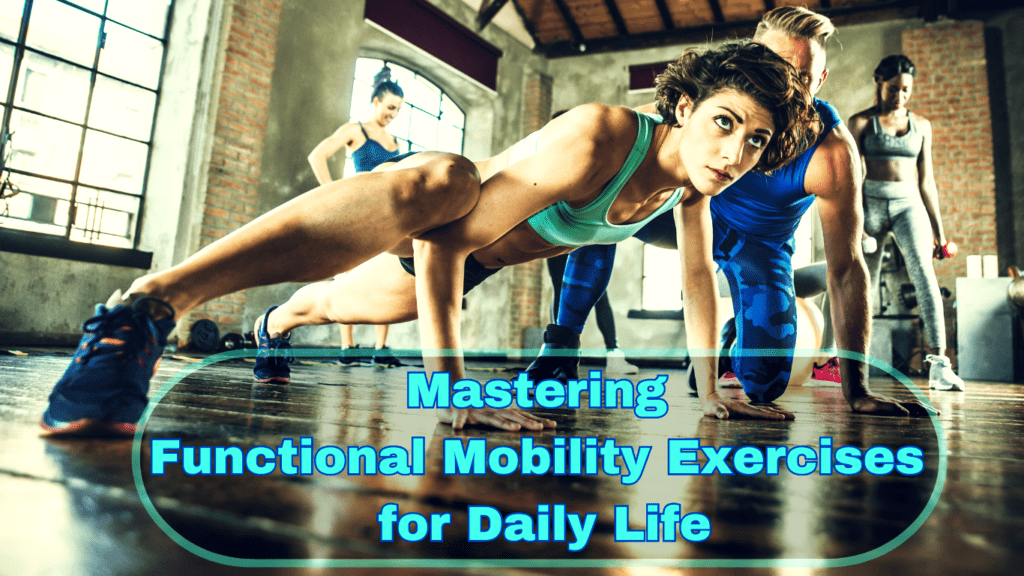
What Are Functional Mobility Exercises?
At their core, functional mobility exercises are designed to improve the body’s ability to move efficiently and effectively in everyday situations. Unlike traditional strength training or cardio workouts, these exercises focus on enhancing your range of motion, stability, and coordination. They aim to make daily activities—like bending down to tie your shoes or reaching for an item on a high shelf—easier and more comfortable.
Why is Functional Mobility Important?
Incorporating functional mobility exercises into your routine is crucial for several reasons. First and foremost, they help prevent injuries by improving joint flexibility and muscle balance. When your body moves more fluidly, you’re less likely to strain muscles or develop chronic issues.
Additionally, functional mobility exercises support overall health by addressing the stiffness and discomfort that can arise from sedentary lifestyles or repetitive movements. For example, if you spend long hours sitting at a desk, your hip flexors and lower back may become tight. Regularly practicing these exercises can counteract this tightness and reduce the risk of back pain.
What Will You Learn?
In this article, you’ll discover a variety of practical exercises designed to enhance your mobility. We’ll cover a range of movements targeting different areas of the body, including stretches to increase flexibility and exercises to build strength and balance. We’ll also delve into the science behind these exercises, so you understand how they contribute to your overall health.
By integrating functional mobility exercises into your daily routine, you can improve your movement efficiency, reduce discomfort, and enjoy a higher quality of life. Stay tuned as we explore these exercises in detail and provide actionable tips to help you get started.
Subscribe And Get Our Free E-Book:Unlocking The Power Of Nutrition-Supplements, Substitutes, and Superfoods!
Understanding Functional Mobility Exercises for Daily Life: A Deep Dive into Everyday Movement
To truly grasp the importance of functional mobility exercises, it’s essential to first understand what functional mobility entails.
What is Functional Mobility
Functional mobility refers to the body’s ability to move freely and effectively in everyday activities. Unlike general flexibility, which focuses on the range of motion of specific joints or muscles, functional mobility integrates flexibility with strength and coordination to perform tasks efficiently. For instance, being able to reach overhead or squat down to pick something up without discomfort or strain reflects good functional mobility.
This concept goes beyond simple stretching or strength training. While flexibility exercises might improve how far you can stretch, and strength training can increase muscle power, functional mobility exercises work to combine these elements into fluid, practical movements. This integration ensures that not only can you move your body parts through their full range of motion, but you can also do so effectively and without risking injury.
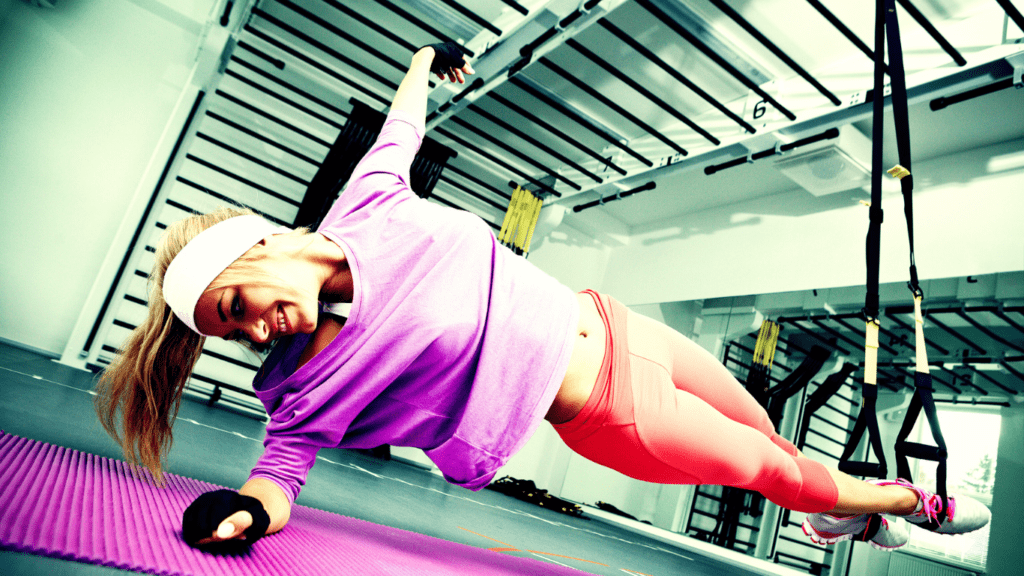
Scientific Background
To understand why functional mobility exercises are so effective, it’s useful to consider the anatomy and physiology involved.
Anatomy Overview
Several key muscles and joints play a crucial role in mobility:
- Hip Flexors: These muscles, located at the front of your hips, are essential for movements like lifting your knees and bending at the waist. Tight or weak hip flexors can limit your range of motion and affect your ability to perform daily activities comfortably.
- Shoulders: The shoulders are incredibly versatile, allowing for a wide range of arm movements. Strong and flexible shoulders contribute to activities such as reaching overhead or lifting objects.
- Core: The muscles in your abdomen and lower back, collectively known as the core, provide stability and support for almost all movements. A strong core helps maintain balance and proper posture, reducing the risk of injury.
Physiology
Mobility exercises impact joint health and muscle function in several ways. When you engage in functional mobility exercises, you stimulate blood flow to the muscles and joints, which helps keep them healthy and responsive. This increased circulation helps deliver essential nutrients to the tissues and removes metabolic waste products.
Improving mobility also affects muscle function by enhancing the coordination between muscles. For example, when you practice exercises that require complex movements, such as rotating your torso while lifting a weight, you train your muscles to work together more effectively. This improved coordination can lead to more efficient movement patterns and better overall performance in physical activities.
Benefits of Functional Mobility Exercises for Daily Life
The benefits of functional mobility exercises are broad and impactful, touching both physical health and daily life.
Physical Health
One of the primary advantages of improved mobility is injury prevention. When your body moves efficiently, you reduce the likelihood of strains, sprains, and other injuries. For example, strong and flexible hip flexors can help you maintain proper form during activities like running or lifting, decreasing the risk of overuse injuries.
Moreover, enhanced mobility contributes to better physical performance. When your joints and muscles move smoothly and efficiently, you can perform exercises and activities with greater ease and effectiveness. This improved performance can lead to better results in your workouts and more enjoyment in recreational activities.
Daily Life
The impact of better mobility extends into everyday tasks. For instance, reaching for a high shelf becomes easier when your shoulders and upper back are flexible and strong. Similarly, activities like bending to tie your shoes or getting up from a low chair can be more comfortable when your hips and lower back are mobile.
In practical terms, consider how improved mobility affects specific activities:
- Reaching: If your shoulders are flexible and strong, reaching for objects on a high shelf or behind you becomes less of a struggle. This can make tasks like retrieving items from cabinets or adjusting overhead lights more manageable.
- Bending: Improved mobility in your hips and lower back makes bending and squatting easier and more comfortable. Whether you’re picking up a dropped item or gardening, enhanced mobility can help you move more fluidly and reduce strain.
Get Total Body Functional Strength With Just 3 Moves Video
Understanding functional mobility exercises and their benefits highlights the importance of integrating these exercises into your routine. By focusing on the functional aspects of movement, you can improve your overall health, prevent injuries, and make everyday activities easier and more enjoyable. Stay tuned as we continue to explore specific exercises and techniques to enhance your functional mobility.
Key Principles of Functional Mobility Exercises
To get the most out of your functional mobility exercises, understanding key principles can help you maximize their benefits. In this section, we’ll delve into dynamic versus static mobility, progressive overload, and the importance of consistency and frequency.
Dynamic vs. Static Mobility
Dynamic mobility exercises involve movement and are designed to prepare your body for physical activity. They often include movements that mimic the actions you will perform in your workouts or daily life, such as leg swings or arm circles. These exercises increase blood flow, enhance joint lubrication, and activate muscles, making them an excellent warm-up before more intense activities.
On the other hand, static mobility exercises involve holding a stretch in a stationary position for a set period. These exercises are aimed at improving flexibility and lengthening muscles. For instance, sitting and reaching for your toes to stretch your hamstrings is a static exercise. Static mobility is particularly effective after exercise, as it helps in cooling down and restoring muscle length.

When and Why to Use Each Type
Incorporate dynamic mobility exercises as part of your warm-up routine. They help in gradually increasing your body temperature and preparing your muscles and joints for the activity ahead. Using dynamic movements before exercise can enhance performance and reduce the risk of injuries by ensuring your body is ready for the demands of the workout.
Static mobility exercises, on the other hand, are best used during the cool-down phase after your workout or on rest days. They help in gradually lowering the heart rate and improving flexibility by gently elongating the muscles. Implementing static stretches post-exercise can help in reducing muscle soreness and promoting overall recovery.
Chart: Dynamic vs. Static Mobility Exercises
| Aspect | Dynamic Mobility Exercises | Static Mobility Exercises |
|---|---|---|
| Purpose | Prepares the body for physical activity | Improves flexibility and muscle length |
| When to Use | Before workouts as part of the warm-up | After workouts during the cool-down or on rest days |
| Types of Movements | Involves active, controlled movements (e.g., leg swings, arm circles) | Involves holding a stretch in a stationary position (e.g., hamstring stretch) |
| Benefits | Enhances blood flow, joint lubrication, and muscle activation | Promotes muscle recovery, reduces soreness, and enhances flexibility |
| Duration | 5-10 minutes per session | 10-30 seconds per stretch |
| Example Exercises | Leg swings, hip circles, arm circles | Hamstring stretch, quadriceps stretch, shoulder stretch |
Progressive Overload
One of the fundamental principles of any exercise regimen, including functional mobility exercises, is progressive overload. This concept involves gradually increasing the intensity or complexity of your exercises to continue making progress. For example, if you’re performing a hip stretch, you might start by holding it for 20 seconds and gradually increase the duration as your flexibility improves.
Tips for Applying Progressive Overload Safely
- Gradual Increase: Increase the intensity or complexity of your exercises slowly. For instance, if you’re adding a new movement or extending the duration of a stretch, do so incrementally to avoid overstraining your muscles or joints.
- Listen to Your Body: Pay attention to how your body responds to increased intensity. Mild discomfort can be a normal part of progression, but sharp pain or persistent discomfort should be addressed by scaling back and seeking professional advice if necessary.
- Varied Movements: Incorporate different exercises to target various aspects of mobility. For example, if you regularly perform hip stretches, you might also add exercises for shoulder mobility or spinal flexibility to create a well-rounded routine.
Consistency and Frequency
Consistency is crucial when it comes to functional mobility exercises. To achieve optimal results, aim to perform mobility exercises regularly. Ideally, including them in your routine 3 to 4 times a week can lead to noticeable improvements in your movement efficiency and overall flexibility.
Muscle Memory and Mobility
The concept of muscle memory is particularly relevant to mobility exercises. Muscle memory refers to the process by which your body becomes accustomed to specific movements through repetition. When you consistently perform functional mobility exercises, your body starts to adapt to these movements, making them easier and more natural over time.
As you repeatedly engage in mobility exercises, your muscles, joints, and nervous system become more adept at performing these movements. This adaptation not only improves your range of motion but also helps in maintaining the benefits of the exercises with less frequent practice. Essentially, your body “remembers” the movement patterns and performs them more efficiently.
Understanding the key principles of functional mobility exercises can greatly enhance your practice. By incorporating dynamic and static mobility exercises appropriately, applying progressive overload safely, and maintaining consistency, you can improve your functional movement, prevent injuries, and support your overall well-being.
Practical Exercises
Integrating functional mobility exercises into your routine can significantly improve your movement efficiency and overall well-being. In this section, we’ll explore a variety of practical exercises designed to enhance your mobility, including warm-up stretches, core stability exercises, joint mobility drills, and dynamic movements.
Warm-Up Stretches
Starting your exercise routine with effective warm-up stretches prepares your body for more intensive activity. Here are two key stretches to include:
Hip Circles
Description: Hip circles involve rotating your hips in a circular motion to warm up the hip joint and surrounding muscles. This exercise helps in improving hip flexibility and reducing stiffness.
Benefits: Enhancing hip mobility can alleviate lower back discomfort and improve your ability to perform movements that require hip flexibility, such as squats or lunges.
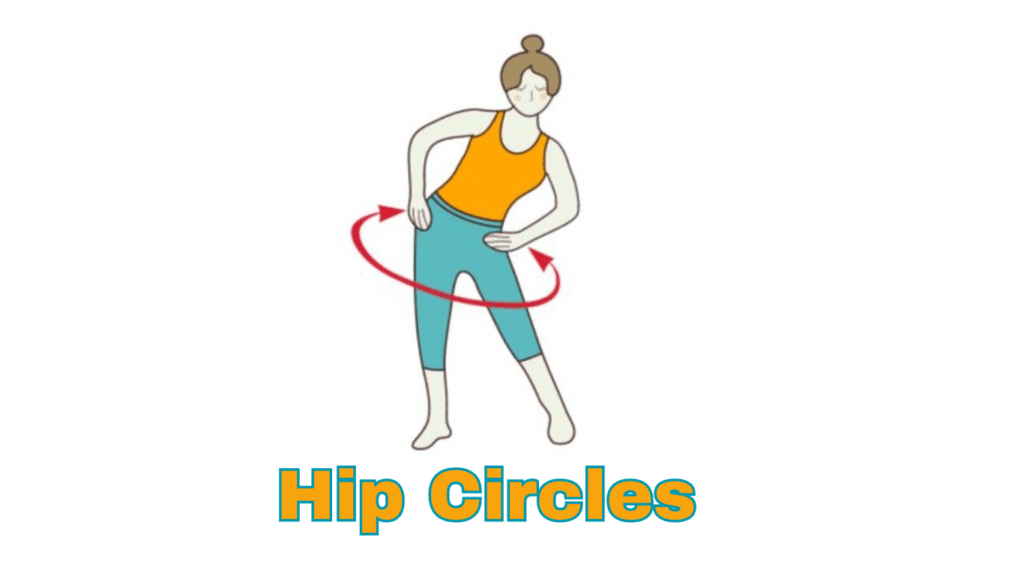
Step-by-Step Instructions:
- Stand with your feet shoulder-width apart and place your hands on your hips.
- Slowly make large circles with your hips, first clockwise for 10-15 seconds, then counterclockwise for the same duration.
- Ensure that the movement is smooth and controlled, engaging your core for stability.
Arm Swings
Description: Arm swings involve swinging your arms forward and backward to mobilize the shoulder joints and increase blood flow to the upper body.
Benefits: This exercise helps in enhancing shoulder flexibility, reducing stiffness, and preparing the upper body for more strenuous activities.
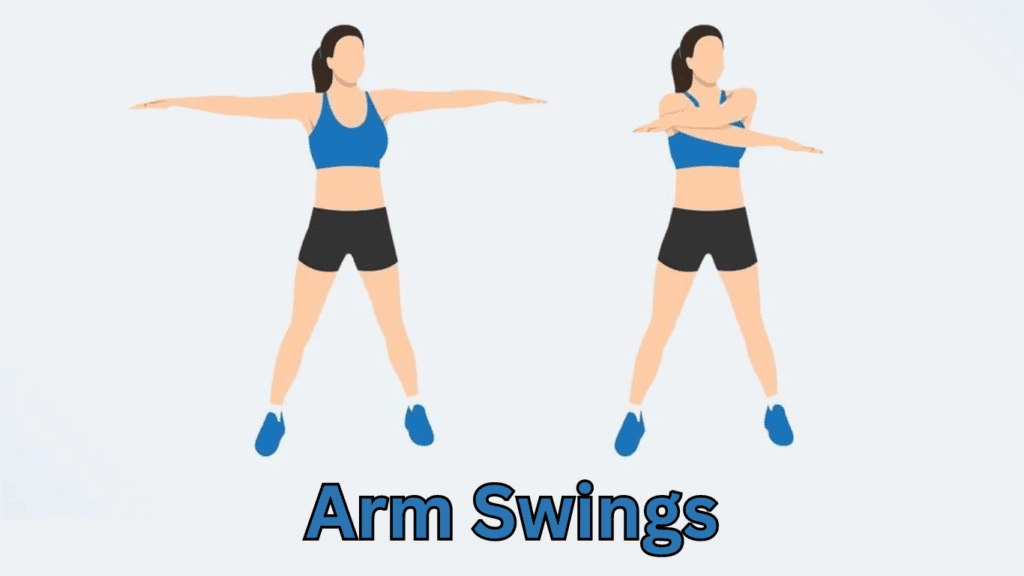
Step-by-Step Instructions:
- Stand with your feet hip-width apart and extend your arms out to the sides at shoulder height.
- Swing your arms forward and backward in a controlled motion, keeping the movement smooth and continuous.
- Perform this for 20-30 seconds, then rest for a few seconds and repeat.
Core Stability Exercises
A strong core is essential for maintaining balance and proper posture. Incorporate these core stability exercises to support functional mobility:
Bird-Dog
Description: The Bird-Dog exercise involves extending one arm and the opposite leg simultaneously while maintaining a stable core.
Benefits: This exercise enhances core strength, balance, and coordination, which are crucial for functional movement and injury prevention.

Step-by-Step Instructions:
- Start on all fours with your hands directly under your shoulders and knees under your hips.
- Extend your right arm forward while simultaneously extending your left leg backward, keeping both straight.
- Hold the position for 2-3 seconds, then return to the starting position.
- Repeat with the opposite arm and leg. Perform 10-12 repetitions on each side.
Plank Variations
Description: Plank variations involve holding a position where your body is aligned in a straight line from head to heels, supported by your forearms or hands.
Benefits: Planks strengthen the entire core, improve stability, and enhance endurance.
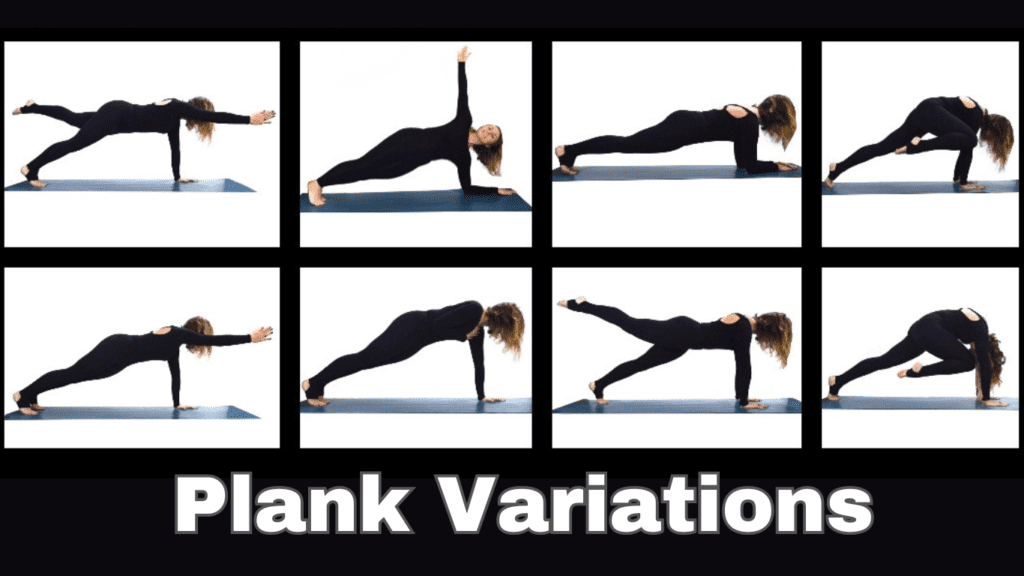
Step-by-Step Instructions:
- Begin by lying face down on the floor. Place your forearms under your shoulders and lift your body onto your toes and forearms.
- Maintain a straight line from your head to your heels, engaging your core and avoiding sagging at the hips.
- Hold this position for 20-60 seconds. To increase the challenge, try side planks or plank with leg lifts.
Joint Mobility Drills/Functional Mobility Exercises for Daily Life
Maintaining joint mobility is essential for functional movement. Incorporate these drills to enhance flexibility and range of motion:
Ankle Dorsiflexion Stretch
Description: This stretch targets the muscles around the ankle joint, improving dorsiflexion (the ability to lift your foot upwards).
Benefits: Improving ankle dorsiflexion can enhance balance and reduce the risk of lower limb injuries.
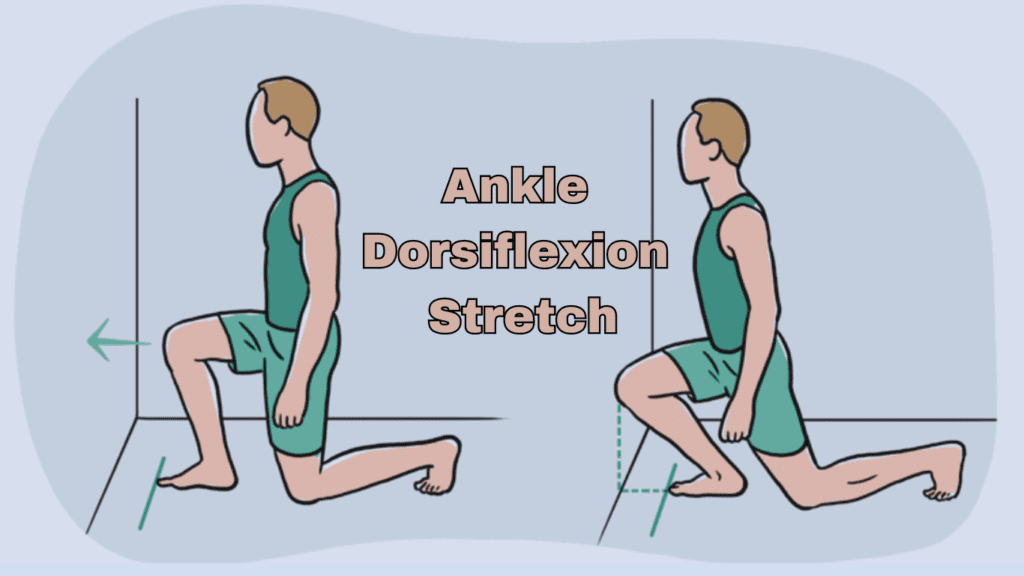
Step-by-Step Instructions:
- Stand facing a wall with one foot a few inches away from it.
- Bend your front knee and press your foot towards the wall without lifting your heel.
- Hold the stretch for 20-30 seconds, feeling a gentle stretch in your calf and ankle.
- Repeat on the other side.
Shoulder Dislocations
Description: Shoulder dislocations involve using a resistance band or stick to move your arms in a wide arc over your head and back, improving shoulder flexibility.
Benefits: This exercise helps increase shoulder mobility and prevent stiffness, especially beneficial for activities requiring overhead movements.
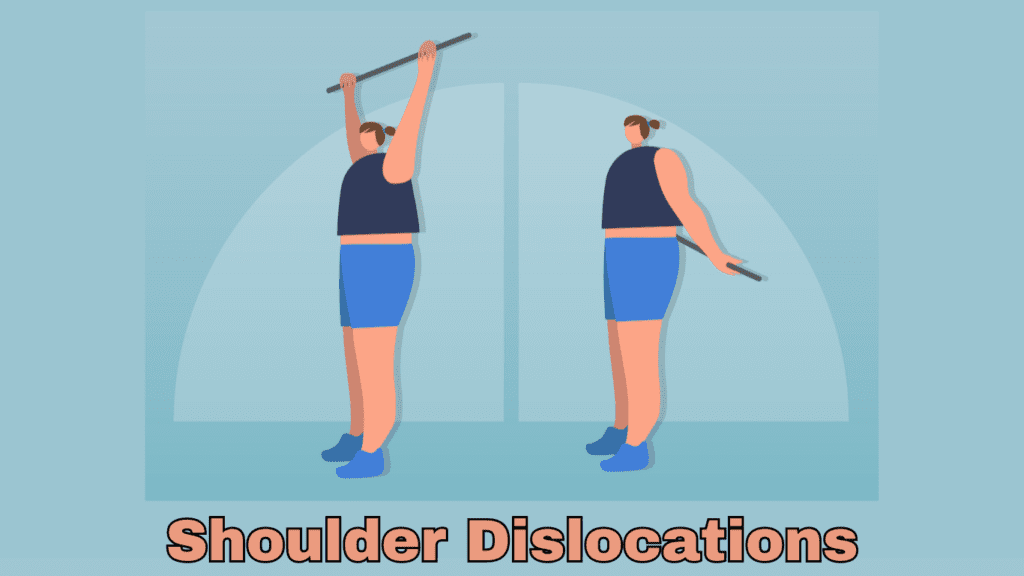
Step-by-Step Instructions:
- Hold a resistance band or stick with a wide grip in front of your hips.
- Slowly raise your arms overhead and behind you, keeping your elbows straight.
- Continue the movement until your hands reach your lower back.
- Reverse the motion to return to the starting position. Perform 10-12 repetitions.
Dynamic Movements/Functional Mobility Exercises for Daily Life
Dynamic movements are essential for enhancing coordination and functional strength. Try these exercises to improve your overall mobility:
Lunges with Torso Twist
Description: This exercise combines a lunge with a torso twist to engage the lower body and core simultaneously.
Benefits: It enhances hip flexibility, strengthens the legs, and improves rotational core stability.

Step-by-Step Instructions:
- Start in a standing position and take a large step forward with your right foot into a lunge position.
- As you lower your body, twist your torso to the right while keeping your hips facing forward.
- Return to the starting position and repeat on the other side. Perform 10-12 repetitions per side.
Bear Crawls
Description: Bear crawls involve moving on all fours with your hips and knees slightly off the ground, mimicking a crawling motion.
Benefits: This dynamic movement engages the entire body, improving coordination, core strength, and overall mobility.

Step-by-Step Instructions:
- Start on all fours with your hands under your shoulders and knees under your hips.
- Lift your knees slightly off the ground and begin crawling forward using your opposite hand and foot.
- Continue crawling for 20-30 seconds, then rest and repeat.
By incorporating these functional mobility exercises into your routine, you can enhance your movement efficiency, prevent injuries, and enjoy a more active lifestyle. Each exercise targets different aspects of mobility, ensuring a comprehensive approach to improving your functional movement.
Chart: Functional Mobility Exercises: Focus and Benefits
| Exercise Category | Exercise Name | Primary Focus | Key Benefits |
|---|---|---|---|
| Warm-Up Stretches | Hip Circles | Hip Mobility | Alleviates lower back discomfort, improves squat and lunge performance |
| Arm Swings | Shoulder Flexibility | Reduces stiffness, prepares upper body for activity | |
| Core Stability | Bird-Dog | Core Strength & Balance | Enhances coordination, prevents injuries |
| Plank Variations | Core Endurance & Stability | Strengthens entire core, improves posture | |
| Joint Mobility Drills | Ankle Dorsiflexion Stretch | Ankle Mobility | Enhances balance, reduces lower limb injury risk |
| Shoulder Dislocations | Shoulder Flexibility | Increases shoulder mobility, prevents stiffness | |
| Dynamic Movements | Lunges with Torso Twist | Hip Flexibility & Core Stability | Strengthens legs, improves rotational stability |
| Bear Crawls | Full-Body Coordination | Improves overall mobility, engages entire body |
Integrating Functional Mobility Exercises into Your Routine
Incorporating functional mobility exercises into your routine can greatly enhance your overall fitness and well-being. In this section, we’ll discuss how to effectively structure a weekly mobility routine, combine mobility exercises with strength training and cardio, and monitor your progress to ensure continuous improvement.
Creating a Routine
To reap the benefits of functional mobility exercises, it’s important to integrate them seamlessly into your weekly schedule. A well-structured routine ensures consistency and effectiveness.
How to Structure a Weekly Mobility Routine
A balanced weekly mobility routine should include a variety of exercises targeting different body parts. Aim to incorporate functional mobility exercises at least 3 to 4 times a week. Here’s a general structure for a weekly mobility routine:
- Warm-Up and Cool-Down: Include mobility exercises as part of your warm-up before workouts and as a cool-down afterward. This helps in preparing your muscles and joints for exercise and aids in recovery.
- Focused Sessions: Dedicate 2-3 days a week to focused mobility sessions. Each session can last between 15 to 30 minutes and should include a mix of dynamic stretches, joint mobility drills, and core stability exercises.
- Rest and Recovery: Allow time for rest and recovery. Ensure that you’re not overworking the same muscle groups on consecutive days to prevent strain.
Example of a 15-Minute Daily Mobility Session
For those with a tight schedule, a quick 15-minute mobility session can be highly effective. Here’s a sample routine:
- Warm-Up (5 minutes): Begin with dynamic stretches such as arm swings and hip circles. These exercises increase blood flow and prepare your body for more intense movements.
- Core Stability (5 minutes): Perform core stability exercises like the Bird-Dog and Plank Variations. These exercises strengthen your core and improve overall stability.
- Joint Mobility (5 minutes): Include joint mobility drills such as Ankle Dorsiflexion Stretch and Shoulder Dislocations. These drills enhance flexibility and maintain joint health.
Combining with Strength Training
Functional mobility exercises work best when integrated with strength training and cardio. Here are some tips on how to combine these elements effectively:
Tips on Integrating Mobility Exercises with Strength Training and Cardio
- Warm-Up Properly: Always start your strength training or cardio workout with mobility exercises. This prepares your body for more intense activity and reduces the risk of injury. For example, performing hip circles and arm swings before a leg workout can enhance your performance.
- Balance Your Routine: Ensure that your weekly routine includes both strength training and cardio sessions along with mobility work. This balanced approach supports overall fitness and prevents imbalances. For instance, you might alternate days of strength training with cardio, incorporating mobility exercises into each session.
- Cool Down and Stretch: After your strength training or cardio workouts, spend a few minutes on static mobility exercises. This helps in gradually lowering your heart rate and stretching out the muscles worked during your session.
Benefits of a Balanced Approach
Integrating functional mobility exercises with strength training and cardio provides several benefits:
- Enhanced Performance: Improved mobility leads to better movement efficiency and performance in both strength and cardio workouts.
- Injury Prevention: A balanced routine helps in preventing injuries by ensuring that your muscles and joints are well-prepared for various types of exercise.
- Overall Fitness: Combining different types of exercises ensures that you’re addressing all aspects of fitness, including strength, endurance, and flexibility.
Monitoring Progress
Tracking your progress is crucial to ensure that your functional mobility exercises are effective and to make necessary adjustments.
How to Assess Improvements in Mobility
- Track Flexibility and Range of Motion: Regularly measure your flexibility and range of motion for key joints. For instance, you can track how far you can reach during a shoulder stretch or how deep you can go in a squat.
- Observe Functional Changes: Pay attention to how your daily movements and workouts feel. Improvements in how easily you can perform activities like bending down or reaching overhead indicate progress.
- Use a Mobility Journal: Keep a journal to record your exercises, durations, and any changes in flexibility or discomfort. This helps in identifying patterns and tracking progress over time.
Adjusting Exercises Based on Progress and Feedback
- Modify Intensity: As you improve, gradually increase the intensity or complexity of your exercises. For example, if a particular stretch becomes too easy, try extending the duration or incorporating variations.
- Incorporate New Exercises: Introduce new functional mobility exercises to target different areas or address specific needs. This keeps your routine fresh and ensures balanced development.
- Listen to Your Body: Always pay attention to how your body responds to exercises. If you experience persistent pain or discomfort, consider adjusting the exercise or consulting a professional.
Integrating functional mobility exercises into your routine involves creating a structured plan, combining these exercises with strength training and cardio, and regularly monitoring your progress. By following these guidelines, you can enhance your movement efficiency, improve overall fitness, and enjoy a healthier, more active lifestyle.
Common Mistakes with Functional Mobility Exercises for Daily Life and How to Avoid Them
Incorporating functional mobility exercises into your routine can greatly enhance your movement and overall well-being. However, there are common mistakes that can hinder progress or lead to injury. Understanding these pitfalls and learning how to avoid them will ensure that you get the most out of your mobility exercises.
Overstretching
Risks of Overstretching and Signs of It
Overstretching occurs when you push your muscles and joints beyond their safe range of motion. This can lead to muscle strains, joint pain, and long-term injuries. Signs of overstretching include sharp pain during or after stretching, excessive muscle soreness, and reduced range of motion.
How to Avoid Overstretching
- Know Your Limits: Understand your body’s limits and avoid pushing too hard. Stretch only to the point where you feel a gentle pull, not pain. It’s important to distinguish between a comfortable stretch and an overstretched muscle.
- Use Controlled Movements: Perform stretches in a controlled manner. Avoid bouncing or jerking motions, which can increase the risk of overstretching. Instead, hold each stretch steadily and breathe deeply to help your muscles relax.
- Gradual Progression: Increase your flexibility gradually. Over time, as your body adapts, you can slowly extend the duration and intensity of your stretches. Rapid increases in stretching intensity can lead to overstretching and potential injuries.
Neglecting Warm-Up
Importance of Warming Up Before Mobility Exercises
Warming up is crucial before starting functional mobility exercises. A proper warm-up prepares your muscles and joints for more intense activity, increases blood flow, and enhances flexibility. Neglecting a warm-up can lead to stiffness, reduced performance, and an increased risk of injury.
Effective Warm-Up Techniques
- Start with Light Cardio: Engage in 5-10 minutes of light cardiovascular activity, such as brisk walking or jogging, to increase your heart rate and body temperature. This prepares your muscles and joints for more strenuous exercises.
- Incorporate Dynamic Stretches: Include dynamic stretches like leg swings or arm circles in your warm-up routine. These movements activate the muscles you’ll be using and improve the range of motion. Dynamic stretches are more effective for warming up than static stretches.
- Focus on Key Areas: Pay attention to the areas you plan to work on during your mobility exercises. For instance, if you’re doing exercises for your hips and shoulders, spend extra time warming up these specific joints and muscles.
Ignoring Pain
Differentiating Between Discomfort and Pain
Understanding the difference between discomfort and pain is essential in preventing injuries. Discomfort during functional mobility exercises is normal as your muscles stretch and adapt. However, pain—especially sharp or intense pain—is a sign that something may be wrong.
When to Seek Professional Advice
- Persistent Pain: If you experience persistent or severe pain during or after mobility exercises, it’s important to consult a healthcare professional. Persistent pain can indicate an underlying issue that needs to be addressed.
- Unusual Symptoms: Seek professional advice if you notice unusual symptoms such as swelling, bruising, or significant loss of function. These signs may indicate an injury that requires medical attention.
- Injury History: If you have a history of injuries or chronic conditions, consult with a physiotherapist or fitness professional to ensure that your mobility exercises are safe and appropriate for your condition.
Avoiding common mistakes is key to maximizing the benefits of functional mobility exercises and ensuring a safe and effective practice. By understanding the risks of overstretching, the importance of warming up, and the need to address pain appropriately, you can enhance your mobility routine and prevent potential injuries. Implement these guidelines to make the most of your exercises, support your overall fitness, and maintain a healthy, active lifestyle.
Embracing Functional Mobility: Key Takeaways and Motivation
As we conclude our exploration of functional mobility exercises, it’s clear that these practices are fundamental to enhancing your overall well-being and physical performance. Let’s recap the importance of functional mobility and motivate you to integrate these exercises into your daily routine.

The Importance of Functional Mobility
Functional mobility exercises are not just about improving flexibility—they’re about ensuring that your body can move efficiently and comfortably through its full range of motion. These exercises play a crucial role in preventing injuries, enhancing athletic performance, and making daily activities easier. When your body moves well, you feel better, perform better, and live better.
Incorporating functional mobility exercises into your routine can lead to substantial improvements in your overall fitness. They help you maintain joint health, build strength, and increase endurance. By focusing on mobility, you’re not only working on your physical capabilities but also investing in your long-term health.
Key Takeaways
- Understand and Implement: Start by understanding what functional mobility means and how it differs from general flexibility and strength. Functional mobility exercises target the specific movements and ranges of motion that are essential for everyday activities. By recognizing this, you can better tailor your exercise routine to address your personal needs and goals.
- Create a Balanced Routine: Structure your weekly schedule to include a variety of mobility exercises. A balanced approach that integrates dynamic and static stretches, core stability, joint mobility drills, and dynamic movements will provide comprehensive benefits. Remember, even a brief 15-minute session can make a significant impact if performed consistently.
- Combine with Other Exercises: Don’t isolate your mobility exercises. Combine them with strength training and cardio to achieve a well-rounded fitness routine. This integration helps improve overall performance, enhances recovery, and prevents imbalances that can lead to injuries.
- Monitor and Adjust: Track your progress to see how your mobility improves over time. Use tools or apps to record your exercises and observe changes in flexibility and movement efficiency. Be ready to adjust your routine based on your progress and any feedback from your body.
- Avoid Common Mistakes: Pay attention to avoid overstretching, ensure you always warm up properly, and differentiate between discomfort and pain. Addressing these common mistakes helps in maintaining a safe and effective exercise routine.
Motivation to Start
Now that you have a comprehensive understanding of functional mobility exercises, it’s time to put this knowledge into action. The journey to improved mobility and overall fitness begins with a single step. Integrating these exercises into your daily routine might seem challenging at first, but the benefits are well worth the effort.
Imagine moving with ease and comfort in all your daily activities—whether it’s bending down to pick up groceries, reaching for an item on a high shelf, or simply enjoying a walk without discomfort. This vision can become your reality through dedicated practice and consistency with your mobility exercises.
Engage and Share
I encourage you to share your experiences with functional mobility exercises in the comments section. Your insights and personal stories can inspire and assist others who are on a similar journey. If you found this article helpful, consider sharing it with friends or on social media. The more people who learn about and engage with these exercises, the more individuals can benefit from improved mobility.
For further reading, there are several scientific studies and articles that delve deeper into the benefits of mobility exercises:
- “The Role of Mobility in Athletic Performance and Injury Prevention” by the Journal of Strength and Conditioning Research.
- “Improving Joint Mobility Through Exercise: A Review” published in the International Journal of Sports Medicine.
- “Functional Movement Patterns and Their Impact on Physical Health” from the American Journal of Sports Medicine.
Tools and Resources
Utilize apps and tools to track your mobility progress. Apps like MyFitnessPal or JEFIT can help you log your exercises and monitor improvements over time. These tools provide valuable insights and keep you motivated.
For personalized guidance, consider consulting with fitness professionals or physiotherapists. They can tailor mobility exercises to your specific needs and ensure that you are performing them correctly and safely. Their expertise can help you address any specific issues and achieve the best possible results.
Functional mobility exercises are a vital component of a healthy and active lifestyle. By understanding their importance, implementing them effectively, and avoiding common mistakes, you set yourself up for success. Start integrating these exercises into your daily routine today, and enjoy the benefits of improved movement, reduced pain, and enhanced overall well-being. Remember, the journey to better mobility begins with a single step—take it today!


